S2023.08.01.1
Files > Conference Series > 2023 > Sumer 1
Bionatura Conference Series Vol 8. No 1. 2023
1st International Scientific Conference on Pure and Medical Sciences at Sumer University. Iraq,
Previous / Index / Next
Morphological and Molecular Characterization of Five Cultivars of Ziziphus spp. Cultivated in Southern Iraq

Ahmed Yousef Lafta Hzaa1,*, Israa Malallah Alkanan2, and Mohammad Radhi Sahib3
1 Department of Horticulture, College of Agricultural, University of Basrah, Iraq.
2 Department of Anesthesia and Intensive Care, Technical Institute, Southern Technical University, Basrah, Iraq.
3 Department of Horticulture, College of Agriculture, Al-Qasim Green University, Babylon, Iraq.
* Correspondence: [email protected],
Available from:http://dx.doi.org/10.21931/RB/CSS/S2023.08.01.1
ABSTRACT
Ziziphus spp. is one of the economic fruit trees whose cultivation spreads in southern Iraq. This study characterized the morphological, molecular, and genetic diversity of five cultivars (Malasy, Normal, Zaytony, Bambawi, Tofahy), using 12 morphological indicators for leaf and fruit and six primers for RAPD technology. The results of the morphological characterization showed that the two cultivars (Normal and Malasy) recorded the highest genetic kinship between them, amounting to 10.04. In comparison, the farthest genetic distance between the two cultivars (Zaytony and Normal) was recorded, which amounted to 29.3. As for the molecular characterization results, the primers produced 113 20 bands, with an average of 18.8 bands for each primer, and the percentage of polymorphism was 100% and unique bands totaling 51 bands appeared, including 17 bands with different molecular weights characteristic of the cultivars. The genetic tree diagram showed the distribution of cultivars in two groups. The combination of morphological and molecular characterization is one of the most important tools that can be relied upon in finding genetic differences and determining fingerprints, especially between types of genders or cultivars of the same species.
Keywords: fingerprints, genetic distance, Morphological, RAPD, Ziziphus.
INTRODUCTION
Sidr (Ziziphus mauritiana Lam. and Ziziphus jujube.) is a perennial evergreen tree and shrub. Its cultivation is spread in tropical, semi-tropical and temperate regions It belongs to the family Rhamnaceae, and the genus is one of the most prominent genera of the family, as it includes about 170 species 1. Sidr trees are considered multi-purpose, as their fruits are eaten fresh due to their high content of vitamins, especially ascorbic acid, carbohydrates, fiber and minerals. It is rich in protein compared to apples and ripe fruits. Sidr trees are used as windbreaks or fuel, in addition to the medicinal benefits of their leaves and bark 2,3.
Morphological markers are the basis that researchers have followed since ancient times in the study of plant classification, and it is one of the methods used to study the genetic relationships between cultivars. These markers to characterize the new cultivars of each plant depend on a set of traits that can distinguish the cultivars from each other 4. With the progress of molecular biology, many molecular markers have emerged that have been used in many fields, especially the study of genetic diversity, finding genetic fingerprints for plants, genetic mapping, finding genetic affinity, and in plant breeding programs 5. The flowering period in Ziziphus (up to 7 years) and during this period the plant needs a lot of agricultural and economic service operations. DNA tags are a very useful tool for cultivar identification during breeding and growth 6. Genetic diversity in the genus Ziziphus was assessed using different systems of DNA molecular markers, such as RAPD and SRAP 7 and ISSR 8.
Molecular analysis was used to study the genetic diversity of three cultivars of Ziziphus spp. in Egypt.Three primers were used for RAPD and ten primers for Sequence-related amplified polymorphism (SRAP). The results showed the emergence of 75 bands by RAPD primers, of which 32 (42.67%) were polymorphic, and 43 (57.33%) were monomorphic. Also, 21 unique bands specific to the cultivar appeared, and 11 standard and unique bands were obtained between each of the two cultivars studied 9.
A study recorded a new species in Nepal based on finding differences in leaf shape, dimensions, tree shape and size and comparing it with other species 10. A study to assess the genetic diversity of five different ecotypes of Ziziphus jujuba Mill based on morphological characteristics in Isfahan Province, Iran, showed that the quantitative features were more important in the ecological patterns such as the dimensions of the leaves and the weight, length and diameter of the fruit, the results also showed a significant negative and positive correlation between some traits 11.
Morphological and molecular characterization was carried out for ten cultivars of Sidr trees (Ziziphus nummularia Burm. F.) grown in different regions of India, A large discrepancy was observed between the cultivars by analyzing five quantitative traits and 25 qualitative morphological traits for leaves, fruits and seeds. ISSR markers also showed polymorphism (86.58%), the genetic similarity value was in the range of 0.45-0.77, indicating a moderate level of genetic diversity among the cultivars, and two of the eleven ISSR primers were also able to generate unique cultivar-specific bands, which can be used to determine the genetic fingerprint of the cultivars Zadber-5 and Zadber-8. This revealed that morphological and molecular markers could be used successfully to determine the genetic diversity and relationship of Sidr cultivars and use them in breeding programs 12.
A comparison of morphological and molecular traits was made to characterize three species of Ziziphus in Iran using a combination of morphological and molecular characteristics. Both morphological and molecular data revealed high internal qualitative differences between the accessions. The percentage of formal polymorphism was 90.49%, and the average content of the information polymorphism was 0.37. At the same time, a significant correlation was recorded between morphological and molecular markers, suggesting this could serve as a valuable tool in optimization programs 13.
Given the economic importance of the studied cultivars, the study was conducted to define the fingerprint, genetic variance, and a statement of genetic relationships and morphology between them. To benefit from them in preparing education and improvement programs for cultivars that are spreading in the south of the country.
MATERIALS AND METHODS
The study was carried out on five cultivars of Sidr (Ziziphus mauritiana Lam. and Ziziphus jujube.) trees (Malasy, Normal, Zaytony, Bambawi Tofahy) planted in different regions of southern Iraq. The study included morphological characterization using 12 leaf and fruit characteristics, which included (leaf length, leaf width, leaf holder length, leaf area, fruit weight, fruit length, fruit width, fruit size, fruit pulp weight, seed weight, seed length, and diameter seed). The molecular study included molecular characterization using six primers of the Random Amplified Polymorphic DNA (RAPD) technique. The molecular study was conducted in the Biotechnology Laboratory at the Department of Horticulture and Landscaping - College of Agriculture - University of Basra. Samples were collected from young leaves, sterilized and preserved until DNA extraction.
DNA was extracted according to the method of 14, and DNA concentration and purity were estimated using a Nano Drop ND-2000 Spectrophotometer (THERMO SCIENTIFIC, USA) at a wavelength of 260 nm, according to the ratio A260/A280. The polymerase chain reaction (RAPD-PCR) was carried out as follows: the initial denaturation phase of the DNA strand was one cycle at 94ºC for a period of 7 minutes, followed by the replication phase was 40 cycles, each cycle included: 30 seconds for the template denatured at 94ºC, then 60 seconds at 94ºC. Heat (32) to bind the DNA template to the primers, then 2 minutes at a temperature of 72 to elongate the primers. Then the final elongation stage, one cycle at 72 ºC, for 5 min.
Data analysis
The morphological characterization was carried out based on the studied traits, as the genetic distances were measured after the Eucliden disstandes matrix was created between the cultivars under study using the Eucliden coefficient. The genetic kinship tree was drawn by applying the unweighted pair group method with arithmetic average (UPGMA) to show the distribution of cultivars into clusters or clusters in the form of a dendrogram. A Principal coordinate analysis (PCA) was also carried out using Past software ver 3, 15.
As for the molecular characterization, they were first included in determining the molecular weights of the bands produced by the polymerase chain reaction (PCR) based on the DNA Ladder 100 bp volume guide produced by Promega company. Using Gel Analyzer 2010a Image Documentation Software. Then, the results of the bands obtained using the above techniques were recorded and converted into descriptive tables in Microsoft Excel by placing (1) when the band is present and setting (0) for its absence. The results were analyzed according to the pre-prepared tables using the biostatistical program Past software ver 3. The genetic dimension was analyzed using the Jaccard coefficient of genetic similarity between the cultivars under study.
RESULTS
Morphological characterization
The analysis results of the main components showed the presence of four factors that contributed to the total cumulative variance between the variables, and the first component had the highest contribution rate of 76.62% of the total variance Figure 1. While the second component contributed 17.65%, while, notably, other components had low contribution rates.
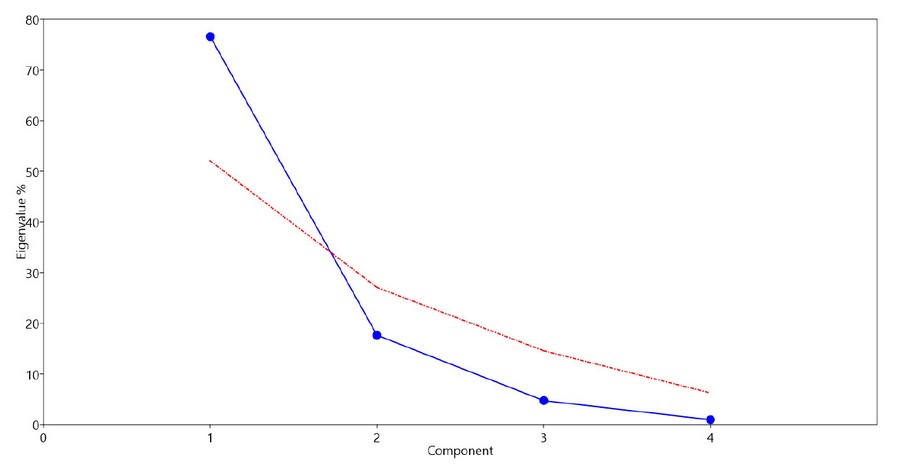
Figure 1. Diagram of imaginary roots for Sidr cultivars based on morphological characteristics.
Figure 2 shows the percentages of the contributions of the variables that represent the differences in the first component (which recorded the highest rate of contributions to the total variance) resulting from the phenotypic traits. It is noticed that the length of the fruit indicated the highest percentage of contributions in finding differences, followed by the characteristic of leaf area, while the rest of the attributes recorded varying rates of changes in the first component.
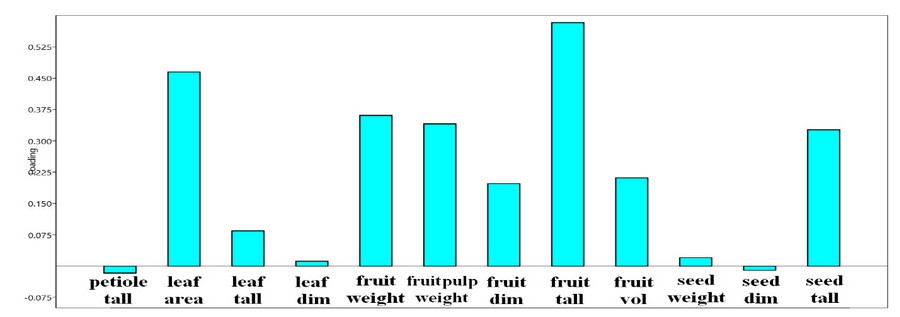
Figure 2. Variable Contribution Ratios in the variance of the essential components based on morphological characteristics.
As for the relationship between the varieties and the morphological features that participate in the study of diversity among the cultivars. In Figure 3 this relationship is shown on the two orthogonal axes. If it is noted from the figure that length of the fruit and leaf area were among the most significant characteristics and greatly affected the association and distribution of varieties, Table 1. The determination of the genetic relationship indicated that these two characteristics are the result of the expression of genes of common origin. In addition, it had a major role in the spacing and convergence of genetic distances between cultivars.
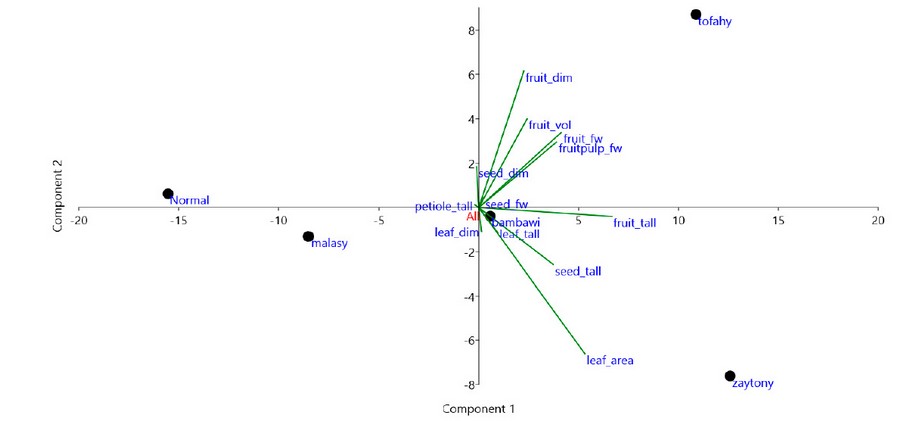
Figure 3. Principal Coordinates Analysis of the contribution of morphological characteristics to the association and distribution of cultivars
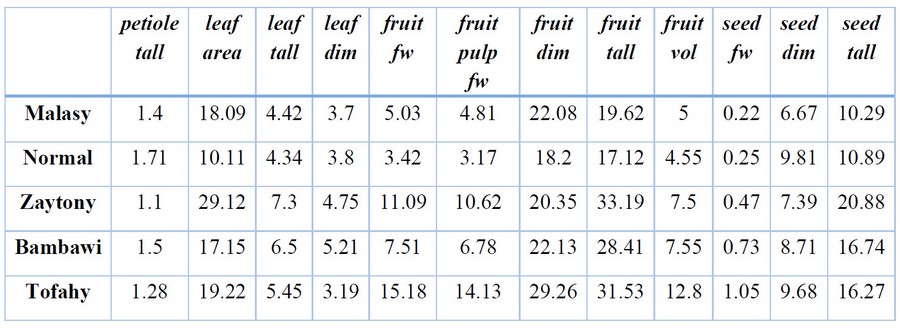
Table 1. Morphological characteristics of the leaf, fruits and seed of the five-sidr cultivars.
The results of the cluster analysis Figure 4 showed that the cultivars were distributed in two groups (A, B). Group A included three cultivars, as the two cultivars (Normal and Malasy) combined into one cluster and recorded the highest genetic kinship between them, amounting to 10.04. In contrast, the Bambawi cultivar was isolated alone. Group B included the two cultivars (Tofahy and Zaytony). The farthest genetic distance measured between the two cultivars (Zaytony and Normal) was 29.38. As for the rest of the cultivars, different genetic dimensions were recorded in Table 2.
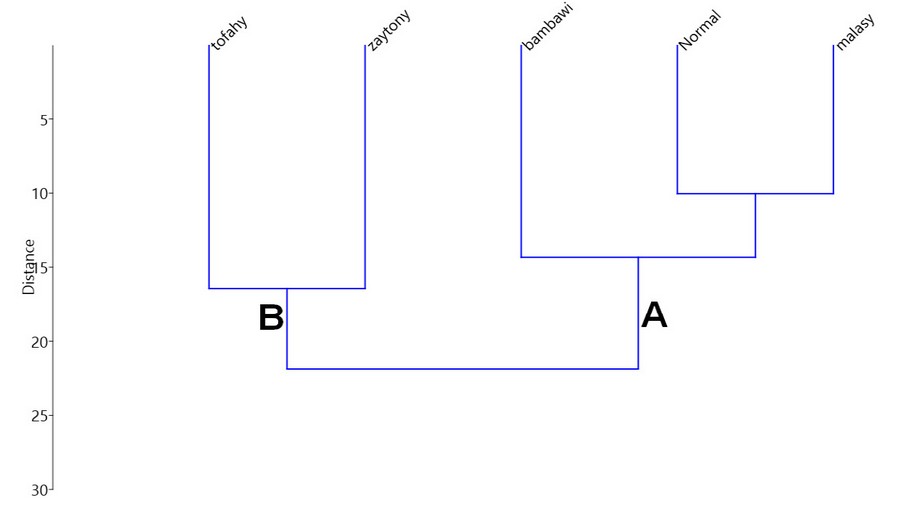
Figure 4 . Dendrogram of Sidr varieties depending on morphological characteristics

Table 2. Matrix of genetic dimensions of Sidr cultivars based on morphological characteristics.
Molecular characterization
The results of cultivar amplification by RAPD primers showed that they varied in the number of amplified bundles, as they produced 113 bands, with an average of 18.8 bands for each primer Table 3. The OPB-09 produced the most significant number of bands and amounted to 24 bands, while the OPB-11 gave less than the number of inflated bands, which amounted to 14 bands Figure 5. As for the number of polymorphic bands amounted to 76 bands, with an average of 12.6 bands for each primer. The OPA-09 produced the highest number of polymorphic bands, amounting to 16, while the OPB-07 gave 9 bands of polymorphism, the lowest number of bands generated by the primers.

Table 3. RAPD primers from the bands, their efficiency ratios and their discriminatory ability in Sidr cultivars.
The primers also produced unique bands totaling 51 bands and an average of 8.5 bands for each primer. OPA-09 gave 14 unique bands, while the OPC-09 gave only three unique bands. Some unique bands distinguished for the cultivar appeared at different molecular weights. It did not appear in the rest of the cultivars, which could be a genetic fingerprint for these cultivars that appeared in it. Also Table 3 shows that the six cultivars gave a high percentage of formal polymorphism in the cultivars amounting to 100%. As for the efficiency of the primers, the OPB-09 recorded the highest efficiency rate of 21.24%, while the lowest efficiency rate was 12.34% recorded by the primer OPB-11. As for the diagnostic ability of the primers only, the OPA-09 gave the highest diagnostic ability of 21.05%, while the OPB-07 gave the lowest discriminatory ability of 11.84%.
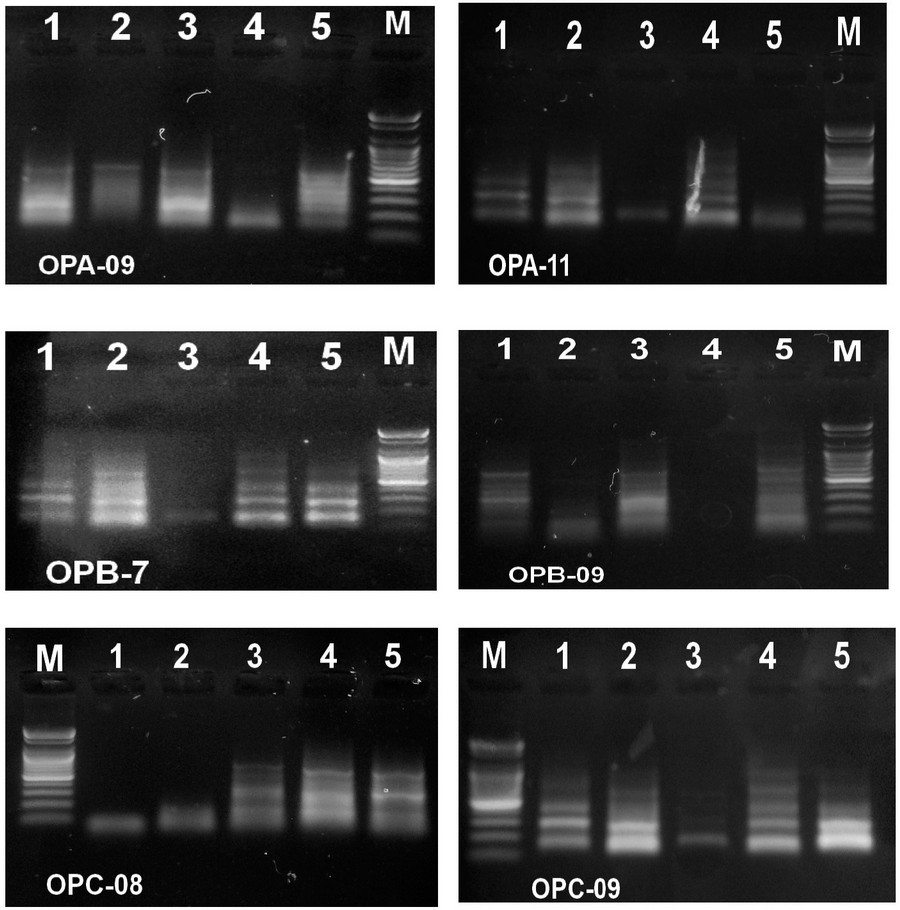
Figure 5. PCR amplification of RAPD six primers in five Sider cultivars on 2% agarose gel, M=100bp plus DNA ladder ( 1. Malasy 2. Normal 3. Zaytony 4. Bambawi 5. Tofahy )
The tree cluster analysis diagram for the cultivars, based on the results of the primers, showed that the cultivars were distributed in two main clusters Figure 6. The first cluster A included the two cultivars (Tofahy and Bambawi). In contrast, the second cluster B included the Normal cultivar, which was isolated by itself and linked to a sub-cluster that included the two cultivars (Zaytony and Malasy) together.
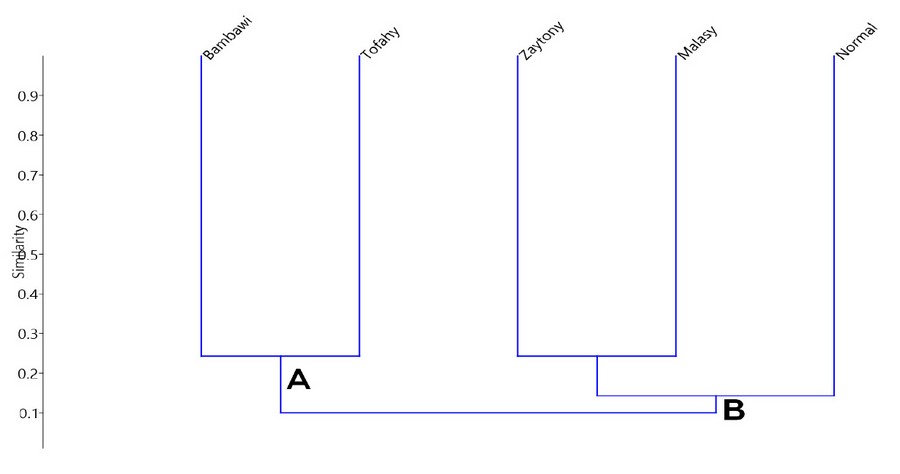
Figure 6. Tree cluster analysis diagram of Sidr cultivars depending on six RAPD primers.
Table 4 indicates the values of genetic similarity between the cultivars, as the highest genetic similarity value was between the two cultivars (Zaytony and Malasy) and amounted to 0.243, As for the lowest value of genetic similarity, it was recorded between the two cultivars (Bambawi and Zaytony), and it was 0.049. The genetic similarity values for the rest of the cultivars ranged between the highest and the lowest, as the values were low, and this indicates the genetic diversity among the cultivars.
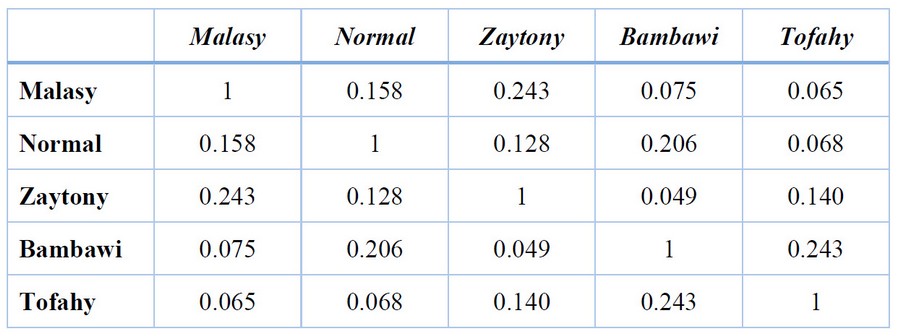
Table 4. Matrix of genetic dimensions of Sidr cultivars based on six RAPD primers.
DISCUSSION
The results of the molecular characterization showed differences in the number of amplified bands and their molecular weights resulting from amplifying samples of cultivars according to the different primer used, resulting from a difference in the number of complementary sites for that primer or the absence of complementary sites for the primer in the genome of Sidr plant. As in 9 studies of genetic diversity, using three RAPD primers gave 75 bands, of which 32 (42.67%) were polymorphic and 43 (57.33%) monomorphic. Also, 21 unique bands specific to the cultivar appeared.
Some leaf and fruit morphological traits were found to be cultivar-specific such as leaf area in combination with fruit length. Although all these traits may change to some extent with changing climatic conditions and other biotic and abiotic factors; Nevertheless they provide a reliable basis for cultivar identification in Sidr.
The phenotypic variance between cultivars that have a common genetic origin is affected by different factors. For example, inter-individual variance in the degree and location of DNA methylation, a genetic phenomenon widely observed in plants, produces new phenotypic variance that can be inherited steadily through generations 16. The phenotypic variance may also be affected by the plant's environmental conditions, which lead to changes in the morphological features, which reveals an expression by the environment of new loci and phenotypes 17.
Morphological assessment of current plant genetic resources is an essential component of managing, using and improving each plant species 18. Wide phenotypic variance within and between Ziziphus species is revealed in the present work.
According to 19, genotype and environmental status are among the major factors influencing plant characteristics and may lead to significant variation in fruit dimensions. Improving the weight and length of fruits is one of the most critical objectives of Sidr breeding programs 20 Therefore, the current cultivars are a rich source of selection and cross-breeding aimed at improving fruit characteristics in Ziziphus species.
The above results show that the discrepancy in the morphological characteristics of leaves and fruits can be explained by genetic factors specific to the species. Also, the environmental impact can indirectly affect the phenotypic traits. It falls under limited levels subject to genetic signals represented by the gene expression processes of the phenotypic characteristics associated with these varieties 21.
The variance between the leaf characteristics affected distinguishing between the varieties, as 12 studied 8 components of the phenotypic characteristics of Sidr, and the highest percentage of the first component was 96.74%. The results were also in agreement with 22, which showed that the features of the fruit's length and diameter significantly impacted the variance between the studied cultivars.
CONCLUSION
Overall, the morphological and molecular analysis indicated that the genetic material under study presented some distinctive features, considering the different traits described in Sidr. However, varieties can be distinguished based on quantitative and qualitative characteristics. Their combination proved to be one of the essential tools that can be relied upon in finding genetic differences and determining fingerprints, especially between types of genders or cultivars of the same species.
Acknowledgments
All the appreciation and thanks go to the Biotechnology Laboratory - Palm Research Center - University of Basra. and The Department horticulture & landscap for supporting this work.
Author Contributions
IMA and AYL conceived of the presented idea. AYL developed the theory and Performed molecular and morphological analyzes MRS and AYL verified the analytical methods. IMA encouraged to investigate and supervise the findings of this work. All authors discussed the results and contributed to the final manuscript.
Conflict of Interest
All authors declare no conflict of interest.
Data Availability Statement
The authors confirm that the data supporting the findings of this study are available within this article and its supplementary materials.
Ethics Approval
Not applicable in this paper
REFERENCES
1. Christenhusz J M, Byng I W. The number of known plants species in the world and its annual increase. Phytotaxa. 2016; 261 (3): 201–217. https://doi.org/10.11646/phytotaxa.261.3.1
2. AL-Marzooq M A. Phenolic compounds of Napek leave (Zizyphus spina-christi L.) as natural antioxidants. J. F. Nutr. Scie. 2014; 2(5): 207-214. DOI: 10.11648/j.jfns.20140205.11
3. Bukar A M, Kyari M Z, Gwaski P A, Gudusu M, Kuburi F S, Abadam Y I. Evaluation of phytochemical and potential antibacterial activity of Ziziphus spina-christi L. against some medically important pathogenic bacteria obtained from University of Maiduguri Teaching Hospital, Maiduguri, Borno State – Nigeria. J. Pharm. Phyto. 2015; 3(5):98-101.
4. Judd W S, Campbell C S, Kellog E A, Stevens P F. Plant Systematic ,a Phylogenetic Approach .Sinauer Associates. Sander and Massachusetts, USA. 1999; 464pp. https://doi.org/10.1080/10635150490445878
5. Xu C, Gao J, Du Z, Li D, Wang Z, Li Y, Pang X. Identifying the genetic diversity, genetic structure and a core collection of Ziziphus jujube Mill. var. jujuba accessions using microsatellite markers. Sci. Rep. 2016; 6(13): 503. http://dx.doi.org/10.1038/srep31503
6. Singh A K, Singh R, Singh N K. Comparative evaluation of genetic relationships among ber (Ziziphus sp.) genotypes using RAPD and ISSR markers. Indian J. Genet. 2009; 69(1):50-57.
7. Li L, Jian-ying P, Rui-xia B. Analysis of the Genetic Relationships in Chinese Ziziphus with SRAP Markers. Agricultural Sciences in China. 2010; 9 :1278-1284. https://doi.org/10.1016/S1671-2927(09)60217-0
8. Al-asadi M T. Study of the phenotypic, chemical and molecular characterization of some cultivar sider Zidiphus spp and the response of the CV.tofahy to spray by salicylic acid and tryptophan in some vegetative and fruit traits M.Sc. College of Agriculture - University of Basra. 2018; 208 pp.
9. Youssef M, Elazab D S. Molecular analysis of Ziziphus spp. cultivars in Egypt. In III International Symposium on Molecular Markers in Horticulture 1100. 2013; 37-44. https://doi.org/10.17660/ActaHortic.2015.1100.4
10. Bhattarai K R, Pathak M L. A New Species of Ziziphus (Rhamnaceae) From Nepal Himalayas. Indian. J.Plant.Sci.. 2015; 4 (2): pp.71-77.
11. Tatari M, Ghasemi A, Mousavi A. Genetic diversity in Jujube germplasm (Ziziphus jujuba Mill.) based on morphological and pomological traits in Isfahan province, Iran. Crop Breeding Journal, 2016; 6(2): 79-85. https://dx.doi.org/10.22092/cbj.2016.107110
12. Akhtar Y, Choudhary R., Sharma K C, Sharma M. Genetic variability and relationship studies of Ber Ziziphus nummularia (Burm. F.) using morphological and molecular markers. Pharmacognosy Journal, 2017; 9 (3). http://dx.doi.org/10.5530/pj.2017.3.71
13. Zarei A, Rezaei A, Esmailpour M, Ebrahimi A. A comparative assessment of morphological and molecular characterization among three Ziziphus species. Physiology and Molecular Biology of Plants, 2021; 27(5): 1007-1025. https://doi.org/10.1007/s12298-021-01000-7
14. Doyle J. DNA protocols for plants. In Molecular techniques in taxonomy , 1991; 283-293: Springer. https://link.springer.com/chapter/10.1007/978-3-642-83962-7_18
15. Hammer Ø., Harper D A, Ryan P D. PAST: paleontological statistics software package for education and data analysis. Palaeontologia electronica. 2001; 4(1): 1-9. https://palaeo-electronica.org/2001_1/past/issue1_01.htm
16. Kalisz S, Purugganan MD. Epialleles via DNA methylation: consequences for plant evolution. Trends in Ecology & Evolution. 2004; 1;19(6):309-14. https://doi.org/10.1016/j.tree.2004.03.034
17. Whitehead A, Crawford DL. Variation within and among species in gene expression: raw material for evolution. Molecular ecology. 2006; 15(5):1197-211. https://doi.org/10.1111/j.1365-294X.2006.02868.x
18. Zarei A, Erfani-Moghadam J, Jalilian H. Assessment of variability within and among four Pyrus species using multivariate analysis. Flora. 2019; 1(250):27-36. https://doi.org/10.1016/j.flora.2018.11.016
19. Gao QH, Wu PT, Liu JR, Wu CS, Parry JW, Wang M. Physicochemical properties and antioxidant capacity of different jujube (Ziziphus jujuba Mill.) cultivars grown in loess plateau of China. Sci Hortic. 2011;130:67–72. https://doi.org/10.1016/j.scienta.2011.06.005
20. Norouzi E, Erfani-Moghadam J, Fazeli A, Khadivi A. Morphological variability within and among three species of Ziziphus genus using multivariate analysis. Sci Hortic. 2017; 222:180–186. https://doi.org/10.1016/j.scienta.2017.05.016
21. El-Nagerabi S A F, Elshafie A Q, Alkhanjari S S. Endophytic fungi associated with Ziziphus species and new records from mountainous area of Oman. Bio. 2013; 14 (1): 10-16. https://doi.org/10.13057/biodiv/d140102
22. Sulusoglu M, Cavusoglu A, Dede, N, Unver H. Morphological, pomological and nutritional traits of jujube (Ziziphus jujuba Mill.). Pomology, Viticulture and Enology. 2014; 49(9): 727-731. https://www.cabdirect.org/cabdirect/abstract/20163271326 https://www.actahort.org/books/1100/1100_4.htm
Received: 26 September 2022 / Accepted: 15 October 2022 / Published:15 February 2023
Citation: Lafta Hzaa A Y, Malallah Alkana I, Radhi Sahib M. Morphological and Molecular Characterization of Five Cultivars of Ziziphus spp. Cultivated in Southern Iraq. Revis Bionatura 2023;8 (1) 1. http://dx.doi.org/10.21931/RB/CSS/S2023.08.01.1